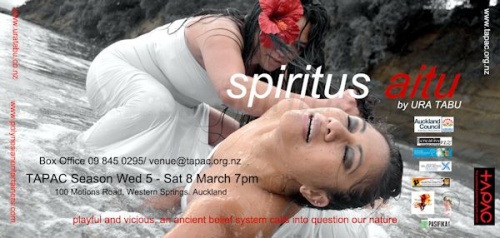Spiritus Aitu
TAPAC - The Auckland Performing Arts Centre, Auckland
05/03/2014 - 08/03/2014
NASDA Theatre, E Block, CPIT, Christchurch
03/10/2014 - 05/10/2014
Production Details
Playful and Vicious an ancient belief system calls into question our nature. Inspired by the Polynesian belief in Aitu (Spirits) as sacred guardians and enforcers of all things taboo, Aitu are watchful of shifts and imbalances within the natural world. Potentially lethal and vengeful if the VA between humans and nature has been disrupted.
Ura Tabu, an all-female dance company, draw on their most primal and maternal protective instincts to create innovative imagery and dynamic movement which interplays between themes of climate change, economic greed, animalistic instincts, and fluid elemental qualities in exploration of the VA.
The line between the spiritual realm and physical will begin to blur in this dynamic showcase of Pacific movement in its rawest state. Let the strength of a woman unfold before your eyes as maternal protectors of life as we know it.
Company Ura Tabu Pacific Dance
Venue NASDA Theatre at CPIT, E Block, Madras Street.
Date/Time Fri 3rd – Sun 5th October at 8.00pm
Duration 60 minutes
Tickets $20, $15 concessions from Dash Tickets www.dashtickets.co.nz or ph 0800 327 484, booking fees apply.
CONTACT URA TABU
FACEBOOK: https://www.facebook.com/uratabu.dance
EMAIL: uratabu_dance@hotmail.com
WEBSITE: www.uratabu.co.nz
SPIRITUS DANCERS
Katerina Fatupaito
Kolopa Simei Barton
Santana Schmidt
Polly Manu-ariki Nofo'akifolau
Mele Taeiloa
Natalie Maulolo Toevai
60 mins
Brave season of connectivity and interplay
Review by Dr Linda Ashley 06th Mar 2014
A single woman carrying a lantern is a poetic beginning – simple, all a dancer has to do is walk. In point of fact walking is notoriously one of the most difficult things to do on stage, and poet Grace Taylor kinaesthetically captivates us from the start, as she does with her evocative verse at the close of Spiritus Aitu. The forces of voice, words and breath are prominent threads woven into this kakala (a fragrant garland of flowers). The raw and deep felt movement vocabulary, less affected by contemporary dance stereotyping, is another of the metaphors used by Tedrow in this integration, synthesis and weaving of knowledge about the human condition and its current imbalances with the planet from which it evolved.
Aitu are spirits who channel a sacred bond between humans and nature. It is interesting that Tedrow depicts these potentially lethal and vengeful spectres as female – maternal protectors of life as we know it. As guardians or enforcers of balancing power in the natural world, that animals and plants are incapable of physically or spiritually protecting, aitu are watchful of shifts whereby the innocent could become victims through no fault of their own.
Moments in forests captured on film are magnified on stage at various points throughout the performance. Feet treading softly on forest floors, faces suspended to the sky, soft sways, languidly undulating arms, chimeric torsos and sustained shifts of curving posture, linger. There are hints of ritual contemplation in chants and closed eyes. Polynesian drums (STKS and Thomas Natoelalofa) crash through to enforce a sense of who is dancing their lives – and maybe, with heavy thudding torsos, bound, percussive grounded, for their lives. The dynamic range in this show is worth seeing.
Movement imagery of birdlife, frantically possessed dogs of war, consuming forbidden flowers, children’s playfulness, tragic tsunami devastation and contemporary weather girls flicker through the ta-va (time-space) of the show. We see familiar sections as well as new, with variable impact in the final results.
It is the connectivity and interplay of the many images that could lead to enrichment of the choreographic form as a whole. Another interesting challenge could involve deeper development of the current striking imagery. What Tedrow and her dancers do, however, is capture a respectful sense of traditional in the now. The dancers are fully invested in the movement, and Tedrow has substantial reason to be grateful for their movement contributions, performance quality and sincerity.
The six year creative process that lies behind this show may seem somewhat of an odyssey in the present day world of dance theatre. Appropriately, however, it seems more in keeping with a Pasifika worldview of how the horizon of the past curves back, sitting on the shoulders of the present – and hovering over the future. This first full-length version of Spiritus Aitu, linking sections from the past creative process, appears to light pathways into its future. As an alternative to choreographers who continually present ‘new’ works, there is merit in this approach, in that sometimes ‘new’ works hold considerable resemblance to former works – and some may say inevitably so.The key for this full-length show could lie in connecting the dots through time and space in a choreographic holism that reflects the holistic power plays of our planet, its people and its flora and fauna. Tedrow has begun this journey with this brave season of contemplations and increasing production values, as provided by a team of associates.
Copyright © in the review belongs to the reviewer





Comments